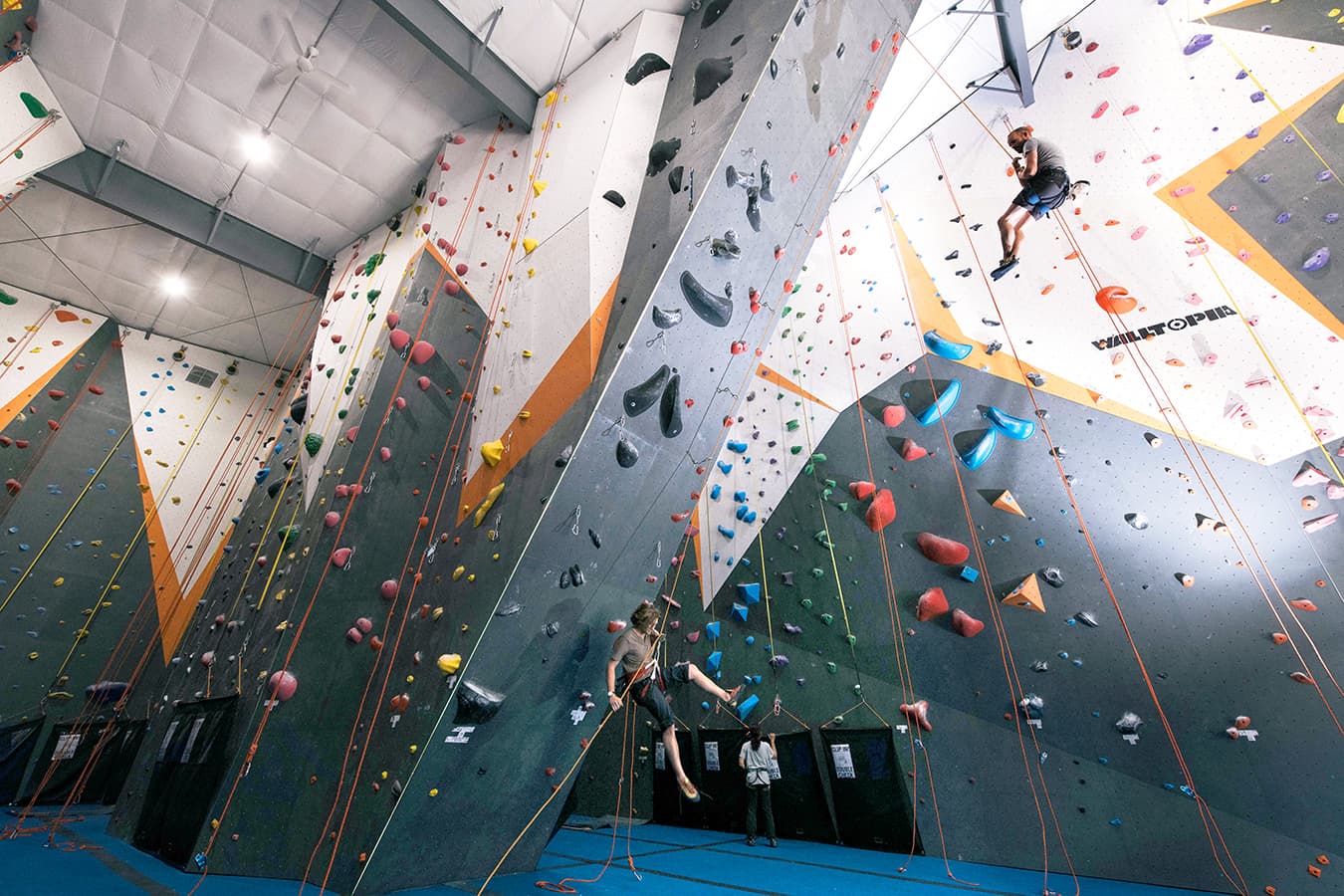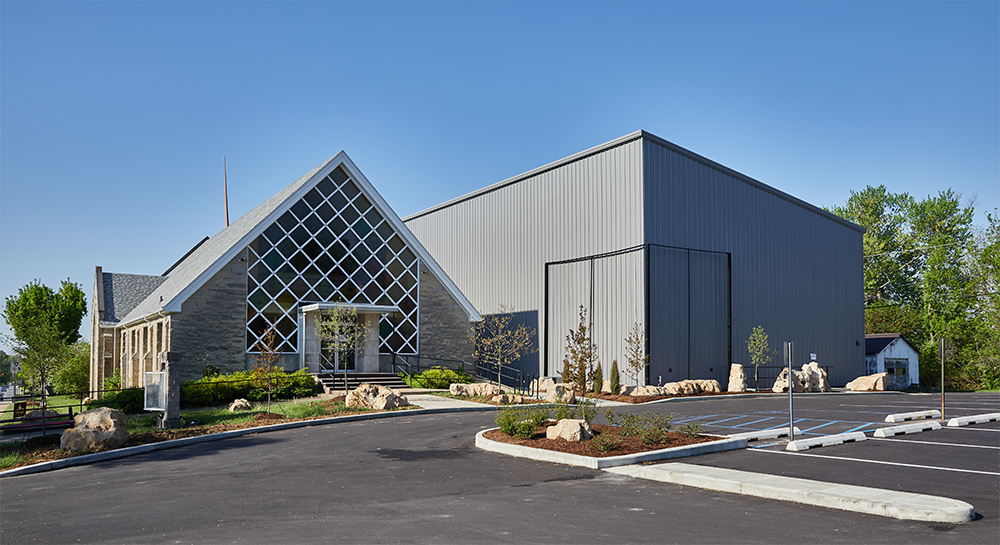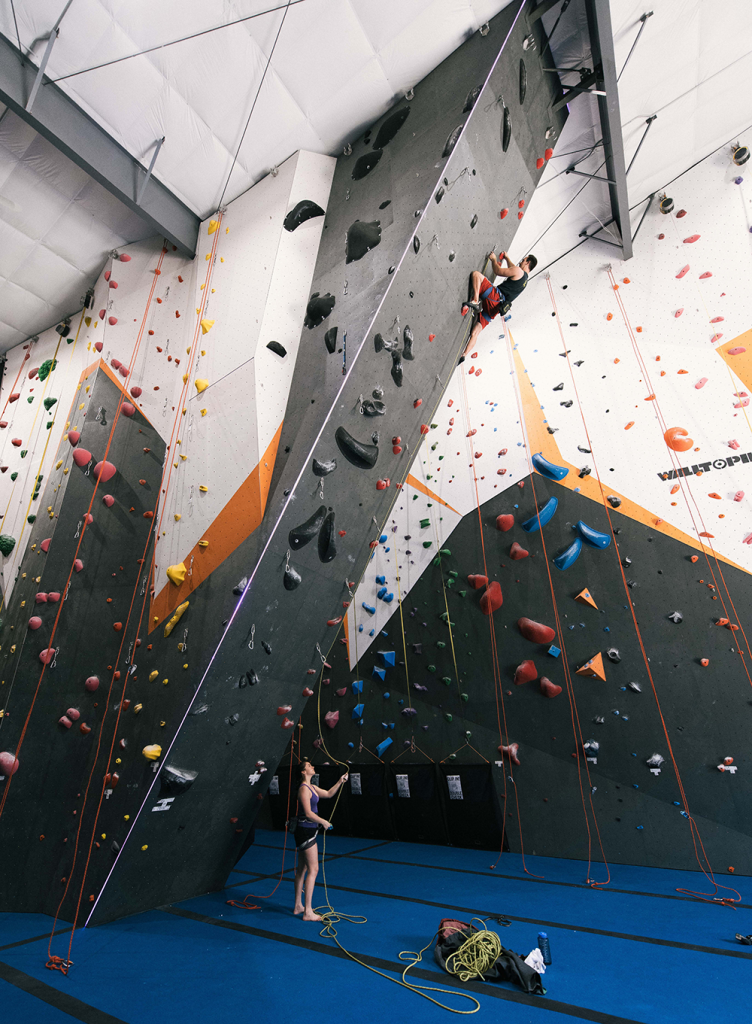— Sponsored Content —

Hoosier Heights offers a variety of climbing experiences and welcomes climbers of all ages and expertise. The new gym has bouldering, a classic belay as well as an auto-belay system, and a ropes room. In addition, the new location in McDoel Gardens has a community room, yoga classes, and exercise equipment.

Hoosier Heights has brought new life to the vacant McDoel Baptist Church on South Rogers Street. The historic church was renovated by Loren Wood Builders and the gym opened in April 2018.
Rock climbing is an exhilarating activity that challenges the body and mind in unique ways. Every climber must take that first step up to the wall, focus their attention on which route they want to take, and grab the handhold to start their thrilling ascent. The process is the same if you’re a beginner or a seasoned climber; only the route is different. With climbing being added to the Olympics and getting attention from obstacle course television shows, there has been a rising interest in the sport from people who have never climbed before. For 20 years, Hoosier Heights has seen new climbers become enthusiasts, and that is why they make a focused effort to ensure everyone feels welcome when they walk into the gym. “Regardless of how you come, experienced or not, climbing solo or with a group of friends, you’ll have access to our entire facility and equipment,” says Joe Anderson, owner of Hoosier Heights.
That facility is new, or at least new to Hoosier Heights. In the spring of 2018, they moved from their south-side location to a renovated church at 1008 S. Rogers St. in the McDoel Gardens neighborhood. The historic church looks much the same on the outside, besides the addition at the back of the building, but inside it is most certainly different. A handful of pews remain in the lobby and the community room, reminders of the many years this building served the community as a place of worship. But instead of sitting vacant, as it had for several years, the building has been reimagined into something with life and activity once again. It remains a place of community, a gathering place for friends and fellow climbers. “This new location is near the B-Line Trail and close to downtown and campus,” says Anderson. “We want to help build a climbing community and make it accessible.”

“We want to help build a climbing community and make it accessible,” says owner Joe Anderson. The new gym is located just a few blocks from the B-Line Trail.
This part of town has been a focal point of economic development, with new businesses like Hopscotch Coffee and Cardinal Spirits just down the street and major city projects like Switchyard Park and the Bloomington Hospital redevelopment nearby. “This area is changing but in an organic way with a focus on local,” Anderson says. “Repurposing this space was our way of supporting Bloomington and preserving this historic building.” It also provided an opportunity to update their climbing walls and equipment and offer more programming. “We have a yoga studio in the original sanctuary and a small weight room and cardio training space, so our customers can create a customized, well-rounded experience,” he says.
Longtime climbers at Hoosier Heights appreciate the new facility with climbing walls built by world-renowned manufacturer Walltopia, but it’s also a more inviting space for those trying climbing for the first time. “Our lobby is open and airy, and our staff is very friendly,” says Tyler Bartle, General Manager at the Bloomington gym. “There’s a culture of community and supportiveness with climbers, and that combines with the unpretentious and open nature of Bloomington at our gym,” says Bartle. This creates an atmosphere that is welcoming and helpful, relieving the apprehension someone new to climbing might feel.
Once they’ve signed a waiver and been outfitted with a rental harness and climbing shoes, new climbers receive an orientation and instruction, partly via video and partly from staff. “All of our staff are trained to provide instruction for climbing and using the equipment,” says Bartle. The orientation first covers bouldering, where climbers test their skills on shorter climbing walls (14-16 feet) without a harness. They don’t go as high, but the challenge is still intense, with varying difficulties in routes and some parts of the wall tilting to an overhang. “We mark the routes, so you can easily determine which one is appropriate for your skill level,” says Bartle. Bouldering is great for new climbers, as it requires no special equipment and you go as high as you want, then come back down to a comfortable jumping off spot.

The staff of Hoosier Heights regularly re-work the climbing routes so that the climbing experience is fresh and fun for climbers of all levels. “Creating routes is an art and science,” says General Manager Tyler Bartle.
The ropes room is the next stop of the orientation, and it’s what most people envision when they think of rock climbing: tall walls with ropes hanging down and some intense climbers dangling from daring heights. This is where the intimidation really sets in, but the instructions from staff will set your mind at ease. They explain how to use the auto-belay system, in which solo climbers attach their harness to a belaying mechanism that lowers them slowly and automatically when they release from the wall. The first time you let go of the handholds can be daunting, but as Bartle explains, “The auto-belays are smooth and lower you at a slow, consistent rate.” The new facility has 20 auto-belay routes, so those climbing on their own will have plenty of route options.
For those climbing with friends, they can receive instructions on how to use the top rope equipment. On these climbing routes, the climber hooks onto the rope hanging from the ceiling and their partner hooks into a manually controlled belay. This requires both climbers to understand their responsibilities in the process, and they will practice with the staff member assisting. “We go over the belay system with new climbers until they feel comfortable using it on their own,” says Bartle. Top rope climbing requires a partner, so it’s great for a group activity or even a date night.
The ropes room also has several lead rope routes, which are routes for advanced climbers where the rope is attached to their harness and their belay partner, but instead of looping from the ceiling, the climber must connect to carabiners positioned on the wall. It’s more challenging, and certainly not for beginners, but definitely awesome to observe.
The ropes routes also have varying degrees of difficulty, with color-coded handholds to mark the way. This allows beginners and advanced climbers to use the same space but follow the route that suits them. The staff changes the routes regularly in both the ropes and bouldering rooms, so climbers are constantly facing new challenges. “Creating routes is an art and science,” says Bartle. “We have to consider body movement, capabilities, and what will create a fun climb for any level of climber.” It makes for a unique experience each time you visit the climbing gym.
Hoosier Heights is a mixed-age facility, which means youth and adult climbers are welcome to use the space together. The gym offers classes for inexperienced adult climbers and camps and a climbing club for youth. It’s important to note that even though kids are encouraged to use the facility, they must be supervised. Belayers must be at least 15 years old, but youth as young as 12 can use the auto-belays, though experience and confidence in using the equipment is also a consideration. “We want everyone to have an enjoyable time, which only happens when kids and adults are using the equipment properly,” says Bartle.

(left) The yoga room is located in the original sanctuary of the old church. Yoga classes are free for Hoosier Heights members and $15 for non-members. (right) “Bouldering” is the term for climbing on smaller formations without ropes or a harness. This is a great way for new climbers to test their abilities.
On any given day, the gym is busy with kids climbing with parents, college students working together to scale the walls, and gym regulars hanging nearly upside down in the bouldering room. There are people attending yoga classes, some warming up their muscles on the stationary bike, and others relaxing in the community room with friends. Like the climbing routes, the climbers vary in ability and just about every other characteristic. “We’ve built a space that is engaging in a variety of ways and to a variety of people,” says Anderson. “You don’t have to make an appointment or have the nicest gear; you just show up and we’ll connect you with what you need to have fun climbing.”
Hoosier Heights is located at 1008 S. Rogers St. and is open Monday–Friday, 10 a.m.–10 p.m. and Saturday–Sunday, 11 a.m.–9 p.m. Find information on pricing, classes, membership, and more at HoosierHeights.com.
— Sponsored Content —

